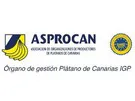It has been more than 80 days since the eruption of the volcano on the island of La Palma started and the lava has already devastated more than 1,170 hectares in its erratic descent towards the coast, engulfing buildings, infrastructure and farms in the municipalities of El Paso, Tazacorte and Los Llanos de Aridane.
The Cabildo of La Palma reports that more than 224 hectares of the area affected correspond to banana plantations, which are the island's economic engine and an important source of employment. In fact, according to data from the 2020 Sustainability Observatory processed by the Fundación Canaria Reserva Mundial de la Biosfera La Palma, bananas are by far the main crop on the island, accounting for 43% of the island's agricultural area currently in production.
"For now, the banana production losses in La Palma are estimated at around 10 million kilos," says Sergio Cáceres, manager of the Association of Banana Producers of the Canary Islands, ASPROCAN, "but in the medium term, we expect this amount to rise to between 30 and 35 million kilos."
"The Canary Islands produces about 410-420 million kilos of bananas annually and, thanks to the growth in the production achieved in Tenerife, the historical averages in weekly shipments to the mainland are holding up, despite this reduction in the volume of fruit produced in La Palma. However, the activity on the island is severely affected and we cannot expect this compensation between islands to continue over time."
"La Palma is a banana-growing island with a very high number of producers. Most growers are smallholders and the average size of the plantations is half a hectare," says Sergio. "Bananas are essential for the livelihood of the entire Aridane Valley. The sector accounts for more than 30% of all direct jobs in the most affected municipalities, so if the activity is not recovered, the whole area is doomed."
In the course of these long two and a half months, the lava has not only burned down farms; it has also blocked roads, isolated plantations and destroyed irrigation systems, while the ash has covered the surface of the entire island damaging plants and fruit, and has even buried greenhouses under its weight. It is worth noting that in November it was estimated that the volcano had expelled around ten million cubic meters of ash; an already almost unimaginable amount that is increasing significantly day by day.
"However, if there is an island in the archipelago that has experience in recovering from a disaster of this magnitude, it is La Palma," says Sergio Cáceres. Fifty years ago, at a time when current technologies did not exist, the island already recovered from the Teneguía eruption and is now the second largest banana-producing island in the Canary Islands. According to the manager of ASPROCAN, the land affected can again be made suitable for cultivation in the future. "In fact, abandoning bananas and finding a new focus for the island's economic and social activity would be much costlier, with the added uncertainty of whether such an alternative would work out."
More reasonable marketing criteria
The Spanish banana is the only banana in the world that has a differentiated quality seal: the Protected Geographical Indication Plátano de Canarias. This recognized quality, together with the promotions carried out by the sector, led by ASPROCAN, has allowed the fruit to remain popular among Spanish consumers for decades. And now the sector is also receiving their support and solidarity, as shown by the many public and private initiatives that have been launched to help La Palma and its banana producers.
For its part, the Spanish Government has allowed a temporary exemption from the marketing standard for the bananas from La Palma affected by ashes which are fit for consumption. The goal is to facilitate their sale to certain marketing channels. Meanwhile, Plátano de Canarias has created a special label for La Palma bananas that identifies them and explains to consumers the reason for their aesthetic damage.
"Marketing standards are closely linked to the product's appearance. Marketing bananas of higher or lower quality depending on what their skin looks like goes against the environmental objectives set by the European Union and pursued with its Farm to Table Strategy," says Sergio Cáceres. "This situation should make it clear that the marketing criteria should be more reasonable and consistent with the objectives we share."
 For more information:
For more information:
Sergio Cáceres
ASPROCAN
P.º Milicias de Garachico, 1
38002 Santa Cruz de Tenerife, Spain
Tel.: +34 922 535 142
asprocan@platanodecanarias.es
www.platanodecanarias.es
